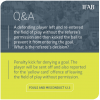If you call over a player to issue a caution and before you can take their name an incident occurs which the same player should be shown a direct send off, do you caution first and then immediately dismiss or is it correct to go straight to the red?
If the latter I assume you only report the dismissal?
If the latter I assume you only report the dismissal?




